It's a Bird... It's a Plane! – Bundu Masks
PRIMITIVE - Thursday, August 14, 2014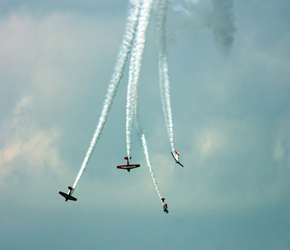 |
|
By Misaki Imagawa
Just a week after I moved to Chicago, I woke up to the rumble of airplanes zooming over my apartment. It was the annual Air and Water Show that my landlord had told me about. Rather than face a room full of moving boxes and half constructed furniture, I dashed out the door to see what all the fuss was about. The show was like nothing I had ever seen before. At times I was certain the planes weren’t flying at all – they were plummeting – as they nose-dived toward Lake Michigan. I was so engrossed with what was happening in the sky that I sat at the beach for hours without shade or sunscreen. The result was a very painful sunburn.
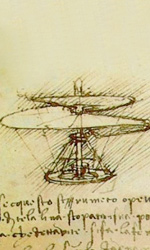 |
|
That night, as I lay awake in too much agony to sleep, I thought back to my childhood dream of being able to fly. I was not alone in this dream. Mankind’s fascination with flight reaches back to ancient times. Just think of Leonardo DaVinci and his flying machines. Many religions feature stories of divine beings possessing the ability to fly such as biblical angels or the half-man half-bird deity, Garuda. Even in mythology there are tales of mortals, like Icarus and Daedalus for example, who experienced the freedom of soaring through the skies – if only for a little while. From man’s earliest attempts to fly by strapping on bird feathers and leaping from towers to the invention of hot air balloons all the way to the Wright brothers’ first successful flight, the steadfast desire to fly finally took people into the sky – and kept them up there ever since.
As familiar as we are today with the sight of jets and commercial airliners, something still keeps us looking up as they streak across the sky. Do you remember what it looked like to see a plane fly for the first time, to look up and see a shiny mass with wing-like protrusions doing only what birds and gods could do? The impact of aviation has reached all corners of the globe. No one has remained untouched by its rapid development, even the Mende people in the remote villages of Sierra Leone, West Africa. These people have been influenced so much by the sight of modern flight; airplanes overhead have begun to influence their otherwise traditional art form of masking. Evidence of this can be seen in a very unique Bundu mask found in PRIMITIVE ’s collections.
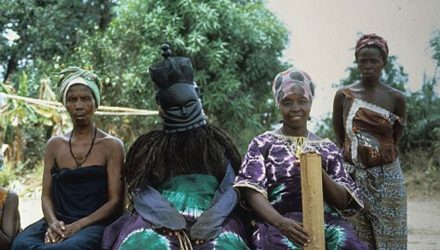 |
The Bundu mask is an essential element of the Sande, a secret society of women holding considerable power in Mende society. At the conclusion of young Mende girls’ initiation into the society the Sowei (Jowei), or highest ranking woman of the Sande, dons the Bundu mask and performs a ritual dance of celebration. Historically, these masks are adorned with elements such as crescent horns, depictions of spirit figures, and regal European-style crowns. However, the Bundu mask in Primitive’s collection is topped with a very different crowning element – a full twin-engine airplane in flight!
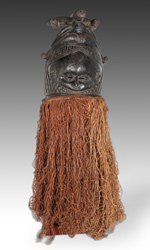 |
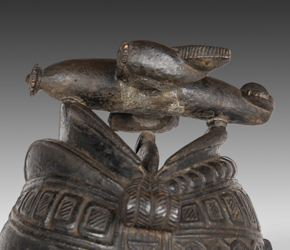 |
Historically, the creation and use of the Bundu mask is deeply rooted in Mende tradition. All the physical elements on the mask hold symbolic meanings and are intended to embody the Mende ideal of beauty. For example, a full high forehead praises wisdom and intellect. Etches on the cheeks reflect scarification marks that are considered highly attractive. Waves along the neck symbolize popular imagery of a feminine spirit rising from the water; and a regal coiffure decorated by cowrie shells symbolizes wealth and status – but an airplane?
A close look at the Bundu mask with the eye-catching plane also includes these very traditional elements. It is a mask that demonstrates the impressive artistry of the Mende people. Yet, what does the plane represent? That remains an open-ended question. Perhaps it is a symbol of humankind’s ingenuity and inventiveness that is just entering the Mende lexicon of symbols, and we’ll soon see it in other types of Mende art? Maybe it illustrates Ngewo, the Supreme Being in Mende religion, who is the creator of the universe and everything in it? After creating the world, Ngewo went up to heaven and rarely intervenes directly in human affairs, so a plane high up in the sky is a logical symbol. Whatever the appearance of the plane means on the mask, the next time you spot a plane passing overhead, maybe even at the next Air Show, ask yourself what the plane on the mask may mean, or what it may mean to you. For thousands of years humans have been enamored by the possibility of flight. The Bundu mask shows that it was, and still is, a fascination shared by all.
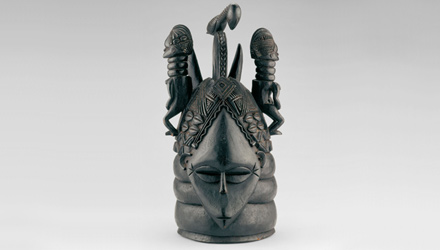
|
|
Download this Article: It's a Bird...It's a Plane.pdf